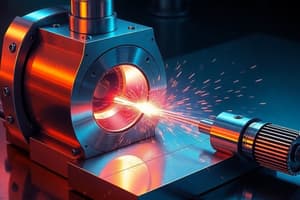Podcast
Questions and Answers
What is an advantage of cryogenic liquid freezing?
What is an advantage of cryogenic liquid freezing?
- Low product weight loss during freezing (correct)
- High maintenance cost
- Dependence on many cryogenic liquid suppliers
- Low cryogenic liquid consumption
What is a disadvantage of cryogenic liquid freezing?
What is a disadvantage of cryogenic liquid freezing?
- High floor space required
- Low initial capital
- Cryogenic liquid is inexpensive
- Cryogenic liquid is expensive (correct)
How is ice formed in a tube ice machine?
How is ice formed in a tube ice machine?
- Water is spread on a belt and frozen
- Water is frozen in a jacketed cylinder
- Water is frozen in a vacuum chamber
- Water is distributed on the inner surface of a vertical tube (correct)
What is the purpose of the knives or similar devices in ice manufacturing?
What is the purpose of the knives or similar devices in ice manufacturing?
What is the temperature in the vacuum chamber where ice is formed?
What is the temperature in the vacuum chamber where ice is formed?
What is the advantage of cryogenic liquid freezing in terms of space?
What is the advantage of cryogenic liquid freezing in terms of space?
What is the primary function of Shell and Coil Equipment?
What is the primary function of Shell and Coil Equipment?
What is the benefit of applying a vacuum in Vacuum Cooling Equipment?
What is the benefit of applying a vacuum in Vacuum Cooling Equipment?
What is the primary purpose of Combined Cooling with Mixing Recirculation?
What is the primary purpose of Combined Cooling with Mixing Recirculation?
What is the most critical factor in freezing foods?
What is the most critical factor in freezing foods?
What happens when large ice crystals form during freezing?
What happens when large ice crystals form during freezing?
Why is quick freezing important in food preservation?
Why is quick freezing important in food preservation?
How much faster is the rate of freezing by spraying a product with liquid nitrogen compared to liquid immersion?
How much faster is the rate of freezing by spraying a product with liquid nitrogen compared to liquid immersion?
What is the purpose of the corrugated lower belt in the production of frozen pellets?
What is the purpose of the corrugated lower belt in the production of frozen pellets?
What is the equilibrium temperature of dry ice and vaporized CO2?
What is the equilibrium temperature of dry ice and vaporized CO2?
What type of equipment is often used for cryogenic N2 freezing?
What type of equipment is often used for cryogenic N2 freezing?
What is the power requirement for a unit using liquid N2 immersion freezing?
What is the power requirement for a unit using liquid N2 immersion freezing?
What is the limitation of using liquid N2 immersion freezing for certain foods?
What is the limitation of using liquid N2 immersion freezing for certain foods?
Flashcards are hidden until you start studying
Study Notes
Freezing Methods
- The rate of freezing by spraying a product with liquid nitrogen is 2.5 times faster than in fluidized bed freezing and 25 times faster than liquid immersion.
- Frozen pellets are produced by freezing foods between two parallel moving metallic belts, with a liquid (e.g., propylene glycol/water mixture) sprayed on the external sides of both belts.
Cryogenic Liquids
- Cryogenic N2 is often used in straight belt-type freezing equipment, where the product is placed on a metallic perforated belt in an insulated cabinet.
- Freezing time with immersion in liquid N2 can be 15-100 seconds, and a unit requires less than 1 kW power.
- Advantages of cryogenic liquid freezing include high freezing speed, low product weight loss, low initial capital, low floor space, and low maintenance cost.
- Disadvantages include expensive cryogenic liquids, high consumption, dependence on few suppliers, and sophisticated storage installations.
Ice Manufacturing
- Ice is formed on the internal or external frozen surface of jacketed cylinders, and knives or similar devices scrape off the ice formed on the surface.
- Ice pellets can be formed by pressing "snow" or ice with relatively much nonfrozen water.
- Cylinder ice or tube ice are produced by freezing water in tubes, and the belt is in a vacuum chamber at -3°C.
Cooling Equipment
- Shell and Coil Equipment uses a shell and coil heat exchanger to cool water and drinks quickly.
- Vacuum Cooling Equipment cools liquids in agitated jacketed vessels by applying a vacuum, reducing cooling time by 10 times.
- Combined Cooling with Mixing uses recirculation, where the product comes out of the tank or silo, flows back after cooling in an efficient heat exchanger, and undergoes mixing.
Freezing of Foods
- Freezing of food is a preservation method combining long shelf life with good product quality.
- The quality of frozen foods depends on good initial product quality, correct application of additional processing methods, right freezing speed, hygienic processing conditions, and proper thawing.
- Freezing must be done quickly to produce small ice crystals, which do not damage the cells of the products.
Studying That Suits You
Use AI to generate personalized quizzes and flashcards to suit your learning preferences.




